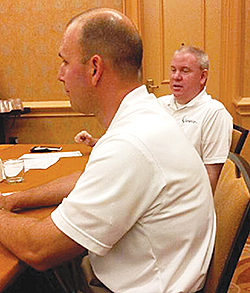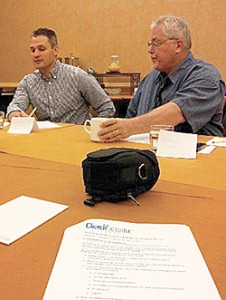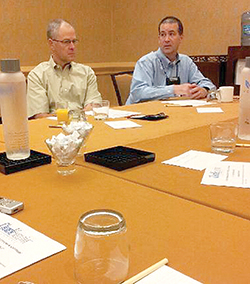
By RaeAnn Slaybaugh
Our Roundtable Panel
Shelby Systems: Mark White, Director of Business & Customer Development
Cool Solutions Group: Tim Cool, Chief Solutions Officer and Project Facilitator
Elexio: John Connell, COO; Allen Ratta; Mark Kitts, Lead Software Architect
ACS Technologies: Marvin Owen, President; Russ Fortier, Manager of Training and Implementation Services
Seraphim Software: Sam Batterman, Co-founder / President; Chris Caldwell, Co-founder / CFO
This summer — at the National Association of Church Business Administration (NACBA) annual conference — Church Executive hosted a live roundtable on a timely topic: church management systems and software. Several high-level ChMS executives joined together to share their expertise.
Let’s talk about underused or lesser-known tools inherent to your management system or software in the areas of:
Finance / giving
Owen: Actually, finance and giving functionalities are often the most used. Those tasks aren’t optional; they’re mandatory. Churches must keep track of people’s giving and have accurate records.
White: I agree. A lot of churches are hiring very competent people for this area because it’s so important.
Kitts: Yes; you have to have that solid foundation of managing the money. It’s a race right now to try to get people to get onboard with online giving, because that makes a church’s income so much steadier. Getting members to use the new methodologies right from their seats, or to use the giving kiosk in the lobby — those are big priorities for churches.
However, I don’t think a lot of church leaders understand that if they want that to happen, they have to promote it. While you might think more modern churches do a better job of this, it actually doesn’t break down that way; it really comes down to the leadership. Do they value new ways of collecting money or not?

Batterman: There’s another piece that churches — especially pastors — are really thinking about right now: taking this highly technological event (giving) and making it worshipful. For many givers, using online giving feels like paying for groceries or buying something on Amazon. There’s a lot we can do as technology companies to fix that, but it involves technology — and that’s potentially very disruptive to very conservative churches.
Fortier: They’re also struggling with the theological side of online giving. We do a lot of coaching on how to fit that conversation into the tidal wave that’s coming. One or two generations from now, we’ll have a cashless society. For a lot of churches, we’re already seeing online giving surpass 50 percent, so it’s a critical conversation to have.
Kitts: I foresee a day when the normal church experience starts with an app. When I move into an area and start going to a church, one of the first questions I’m going to ask is, ‘Where can I find your app?’ It’s just part of connecting with that church — being bought in.
Ratta: Worship attendance is a documented act of participation. It becomes, for us, a leading indicator that something might be amiss. If giving shifts in either frequency or volume, it’s an indicator that something’s going on. An early barometer. A family might be struggling in its relationship with the church or suffering a job loss. Research shows it’s very important for a church to use this data to intervene and minister. The church can be there as a care partner able to use metrics to open a dialog of care.
Sunday attendance data
Batterman: If somebody goes to a Sunday school class or to a small group, that’s a slam dunk for our systems. Related to attendance, the more difficult challenge is tracking the people who come to the worship center, but don’t go to
other events. There’s no notion, necessarily, of who that person is, distinctly.

Even so, the notion of being able to detect people in the congregation without tripping over a copy of George Orwell’s 1984 is a challenge for us. We have tremendous amount of technology available, but you don’t necessarily want church to look like the NSA as people are showing up on Sunday.
The question is how you balance worshippers’ privacy expectations.
White: It really doesn’t do us a whole lot of good to know how many people are in the seats, anyway. You might know Sunday attendance is going down, but what do you do with the data? Meanwhile, small group attendance data is very specific and telling.
Owen: I really think this is one area that’s shifting. It used to be that Sunday attendance was key. Now, engagement is a better metric.
Ratta: Attendance data really has no predictive value. It doesn’t tell you about the health of the church until it’s too late. What does have predictive value are leading growth indicators. What’s your visitor volume? What’s your visitor retention? How is that trending over the last six months? What’s your back-door rate, and how is that trending over the last six months?
Sunday attendance data is like “Where is Waldo?”; it’s like a GPS pin on a map in terms of future direction, church health, and what the church is going to look like in two or three years.
Fortier: Also, attendance in the life of the individual isn’t an indicator of his or her spiritual growth. For example, I’m very involved in my church. I volunteer and I tithe, but I’m there maybe three-quarters of the year. What’s interesting is that if I miss two Sundays in a row, my church is calling me to find out what’s wrong. I like the idea; but the other side of me is thinking what a waste of time it is for that staff member, who could be doing something else.
It all goes back to the core question: What are you doing with the data? What’s the end result?
Batterman: I agree that attendance is increasingly less important. But, it’s a term we must collect nonetheless to comprise the total equation which will explain the “up arrow,” the “down arrow” and so on.
Small group growth / attendance

Kitts: Engagement encompasses a person’s entire relationship with the church. Are they active in small groups? Are they giving? Are they attending? Are they coming to a class that’s key to their disciple development process? The idea is to get a full picture of what this person is doing.
White: To that end, a piece of [our software] tracks whatever the church wants to attract. Obviously, giving and attendance are key metrics. But, did that same person open the e-newsletter? That’s another factor to consider. You can weight and value each of those things; it’s different for every church. How much time is that person spending on the church website, for instance? If you can track all those, weight them, and evaluate them over time, it provides a comprehensive picture of how that person is doing. It can also identify trigger points when the church should reach out and find out what’s going on with that particular member.
Kitts: One thing all of us are struggling with right now, industry-wide, is the screen size issue and the availability of features anytime, anywhere, from any device. You’ve got your mobile phone, your laptop, your tablet and your desktop to consider.
It’s very interesting to see what the big companies are doing. Microsoft, for example, decided to go “mobile first.” It’s very shocking, as they’re known for their Office suite; but, it’s about mobile now. The big software companies are all doing that; we’re doing that, as well.
Small group attendance is a great example of the need to make it easy for people to give you that data — the attendance data, in this case. So, mobile devices are huge for small group leaders.
White: Professional services and consulting are a big area of growth for us. Churches don’t necessarily want to be “trained” — they know we’ve been to 28 churches in the past three weeks. They want us to tell them what those other churches are doing.
Ratta: Growing the Kingdom will always be built on people. When we go in and implement, we’ve got to find people at the church who’ll own a process and be the insight champions for those key processes. Once we do, they carry the ball forward. That reduces the churn rate, which really doesn’t serve the Kingdom.
Connection / engagement
Cool: From a semantics standpoint, people don’t want to be called “visitors;” they want to be called “guests.” When I consult with churches, one of the first things I do is get them to remove the visitor parking signs and replace them with guest parking. A “visitor” implies that person won’t come back.
White: A lot of times, churches call them “first-time attenders.” All our software tracks their activity.
Fortier: Typically, what we find in the area of first-time-attender engagement — and it’s probably true for all of us at the table — is that a good system must be in place. When you get down to the bricks with the church staff and ask them what they’re doing to engage first-time attenders — so we can fit the process to the solution — we often get six different answers. Or, they want our software to do it for them. But, there needs to be some level of accountability among staff as far as making those follow-up calls with first-time attenders. We find this is one of the biggest areas of need in the church.
Ratta: So much is education, isn’t it? Visitors are 100 percent of your growth potential. Though churches say they believe that, when you really try to pinpoint what they’re doing to connect with first-time attenders, all of a sudden many realize they’re not acting like they believe it. We have to educate them in the key processes so that these individuals don’t fall through the cracks.
Connell: I think there’s also a redefining in our culture surrounding membership. Today, people want the flexibility to hop around to different churches without being considered a visitor. How do churches define these people’s engagement if they don’t want to be members? Gauging those key indicators is an inherent challenge for us as software developers.
I don’t know that anyone has answered this challenge completely, but it comes down to an individual discipleship process. How do we set up metrics so that it’s not so much about checkpoints along the way, but more about that person’s spiritual growth?
Cool: What we’re seeing from a congregant standpoint is reminiscent of what we’re seeing from a church structural perspective. No longer am I just southern Baptist; now I’m also part of the Acts 29 Network, the exponential network, and so on. I’m no longer a silo; I’m part of three or four “tribes” from which I can get good information.
Multisite management
Cool: We talk a lot about small groups, but how are you all using your software to meet the needs of the multisite church? Between that and church planting, it looks like it’s going to be the biggest growth and multiplication tool used.
White: That’s a huge — and something we’ve focused on a lot more lately. Everyone wants to do mutli-site now, even small churches. It used to be that once you filled the sanctuary up a couple of times, you’d start thinking about it. Now, you get 600 or 700 people in one area, and churches are trying to do that somewhere else, too. I think we all accommodate that trend with our systems.
And although a church needs to know which people are going to which campus for staffing and administrative purposes, it should really focus on whether or not people are coming to the church’s message, as a whole.
Cool: We’ve seen an interesting trend among the biggest software companies of moving away from having a facility scheduling component. When we started our company, we didn’t’ know our biggest competitors would be Google, Outlook and the paper calendar on the wall. Those are still the tool of choice among churches that call us looking for a demo.
Churches are realizing that if their buildings are going to be seven-day-a-week events, it requires higher organization of the campuses and a better understanding of how their buildings are being used. For example, if I know room 101 is being used seven days a week and room 107 is only getting used once a week, when I start doing my capital reserve planning, I know the carpet in 101 is going to need to be replaced long before 107.
The point is, as a church, how do I know what my real utilization is so I can best plan for our facility outlays?
Want to read Part 1?
This insightful discussion began in our Sept / Oct 2014 issue.


